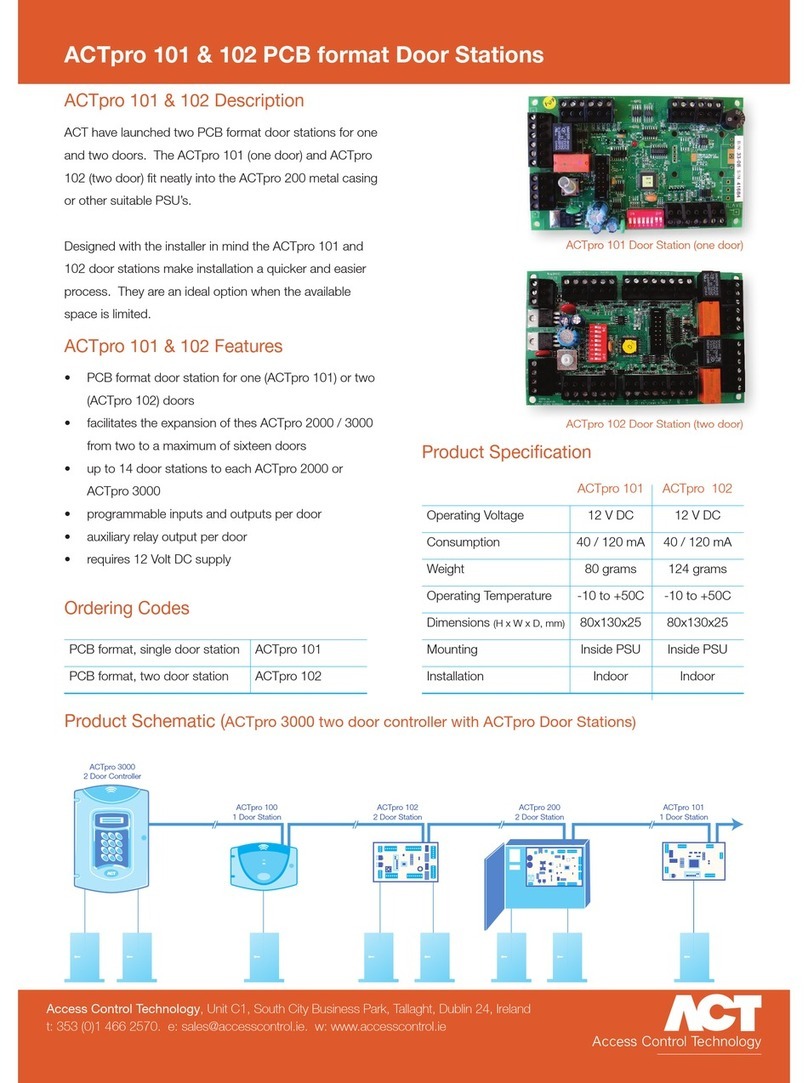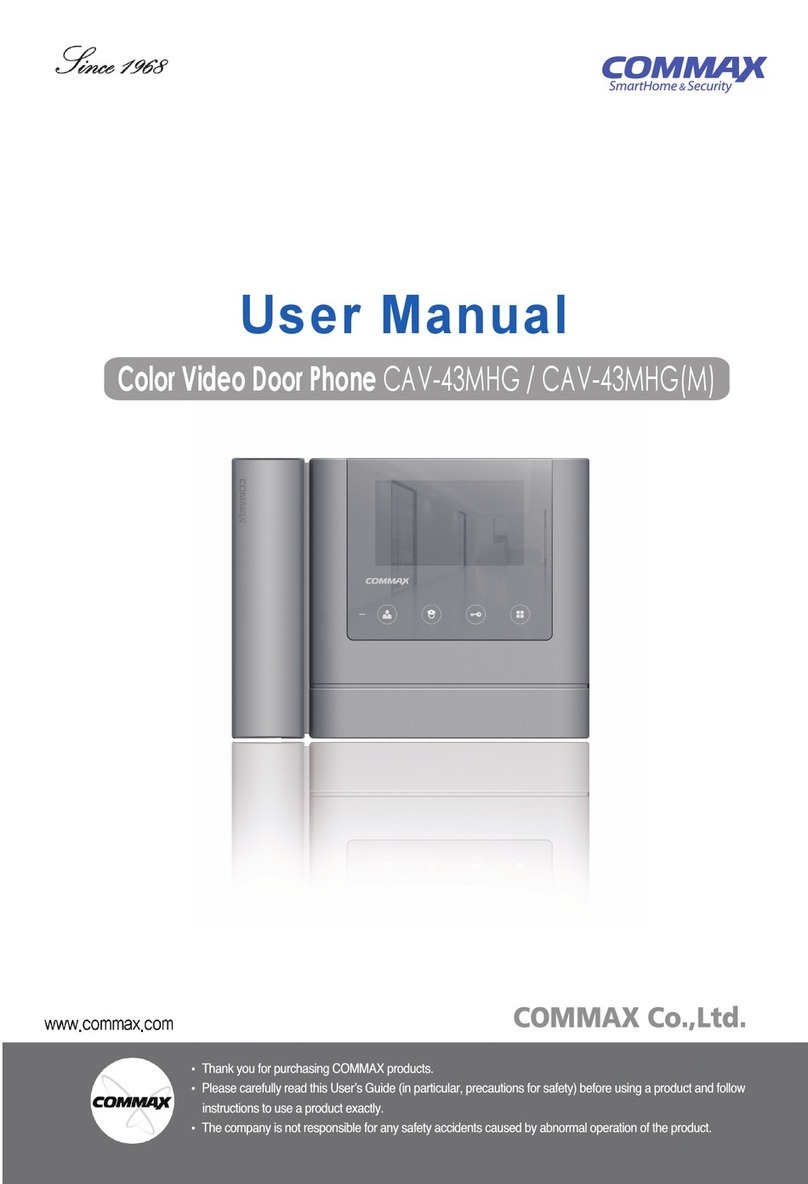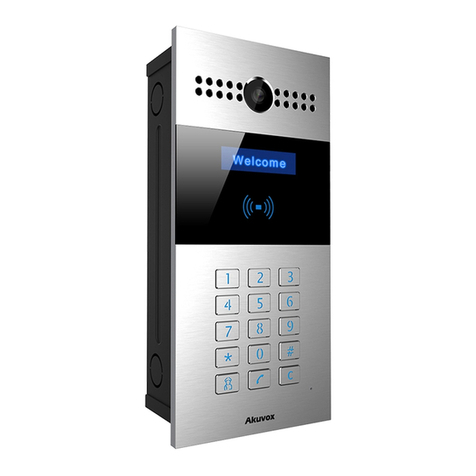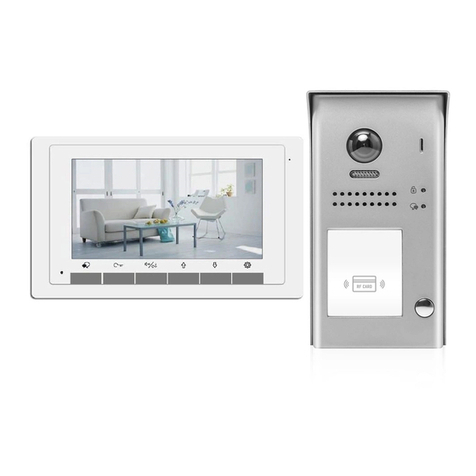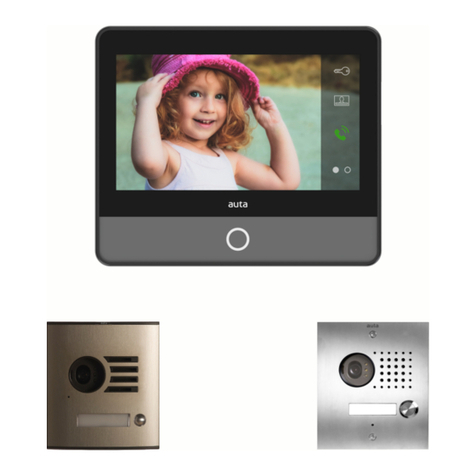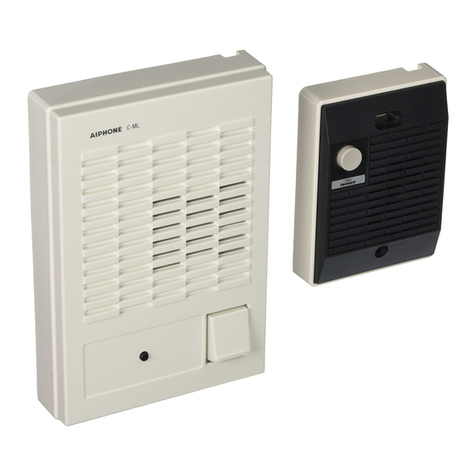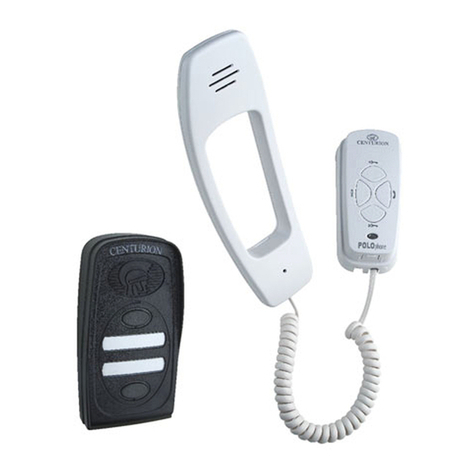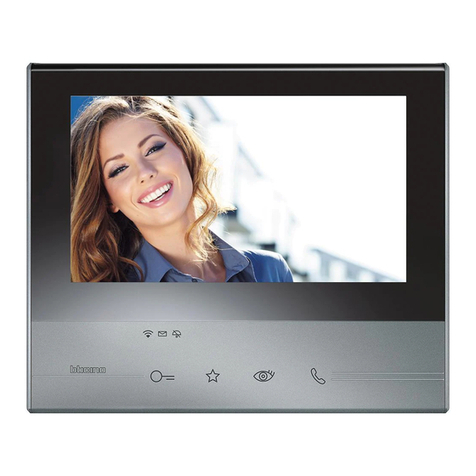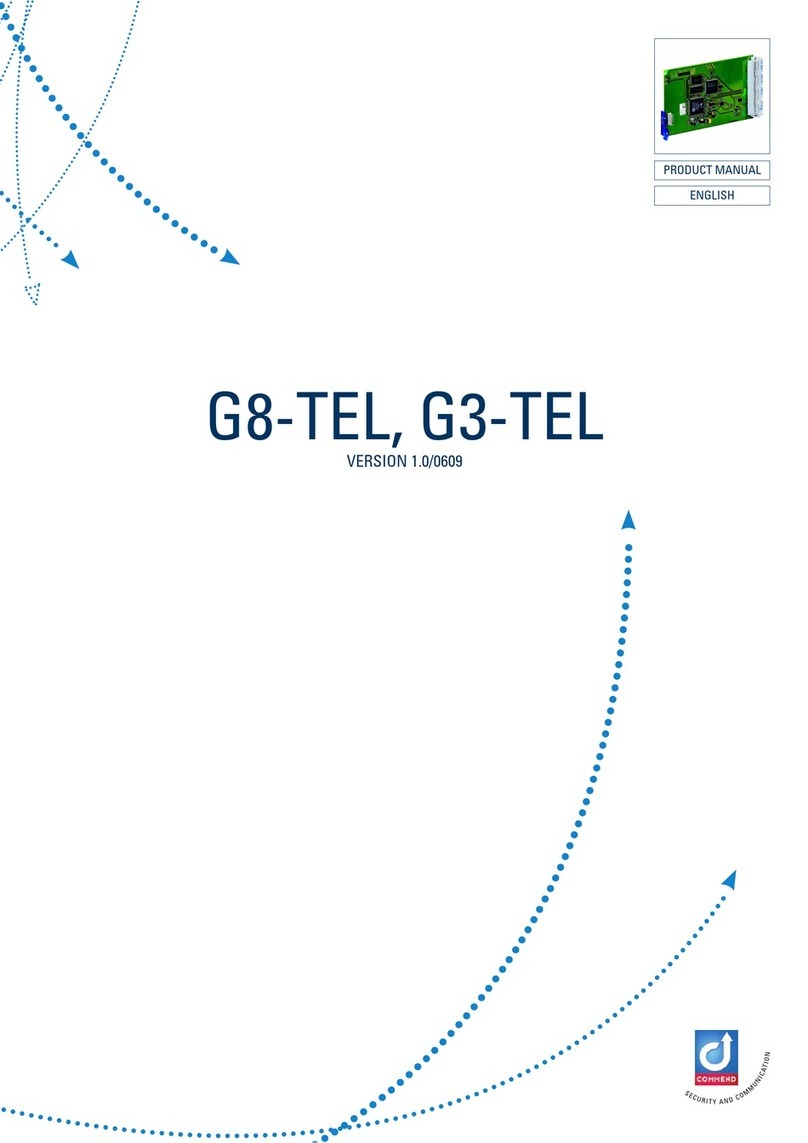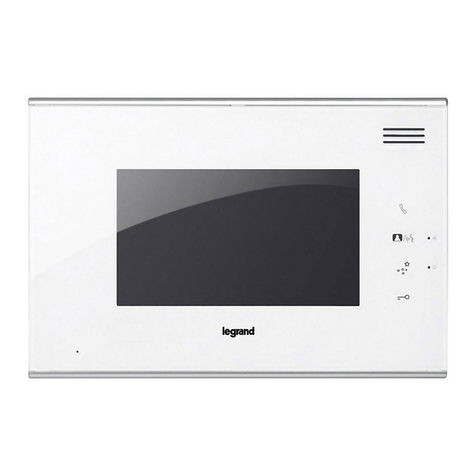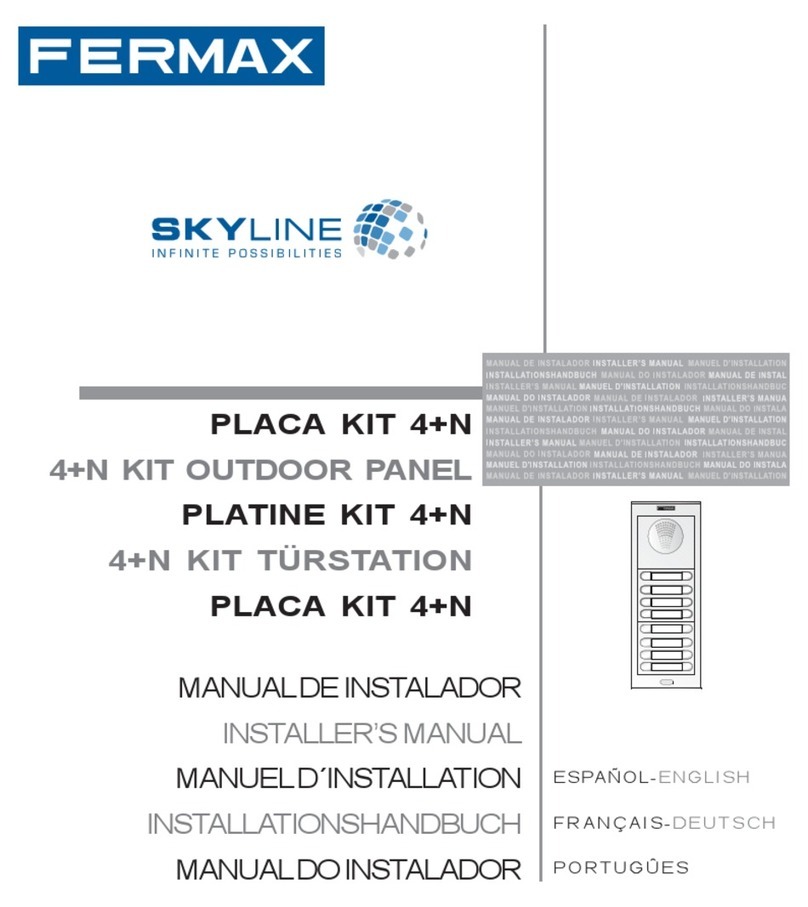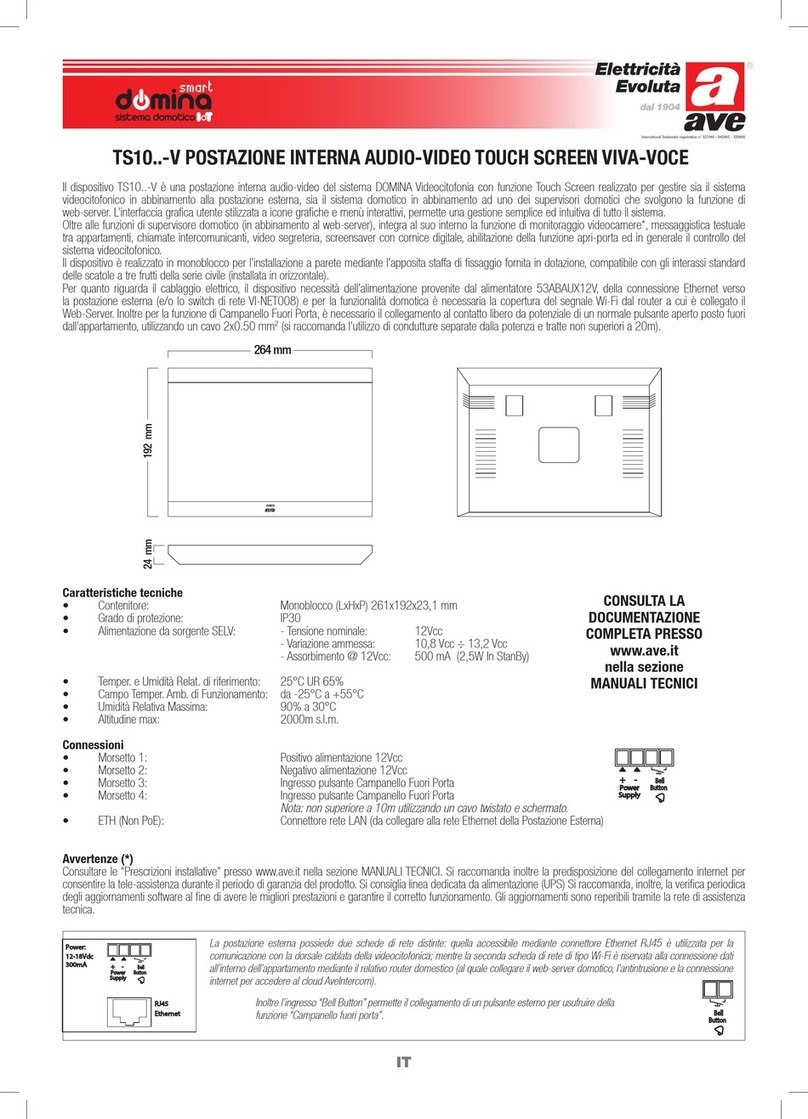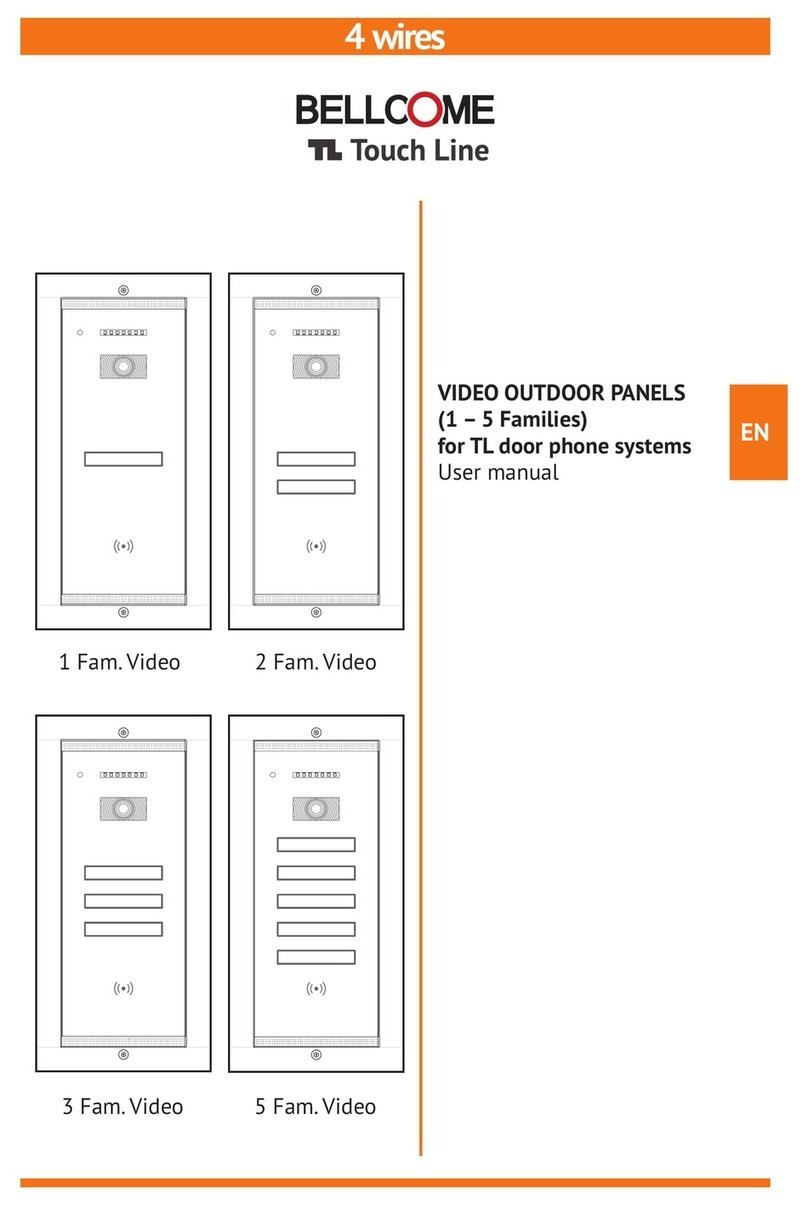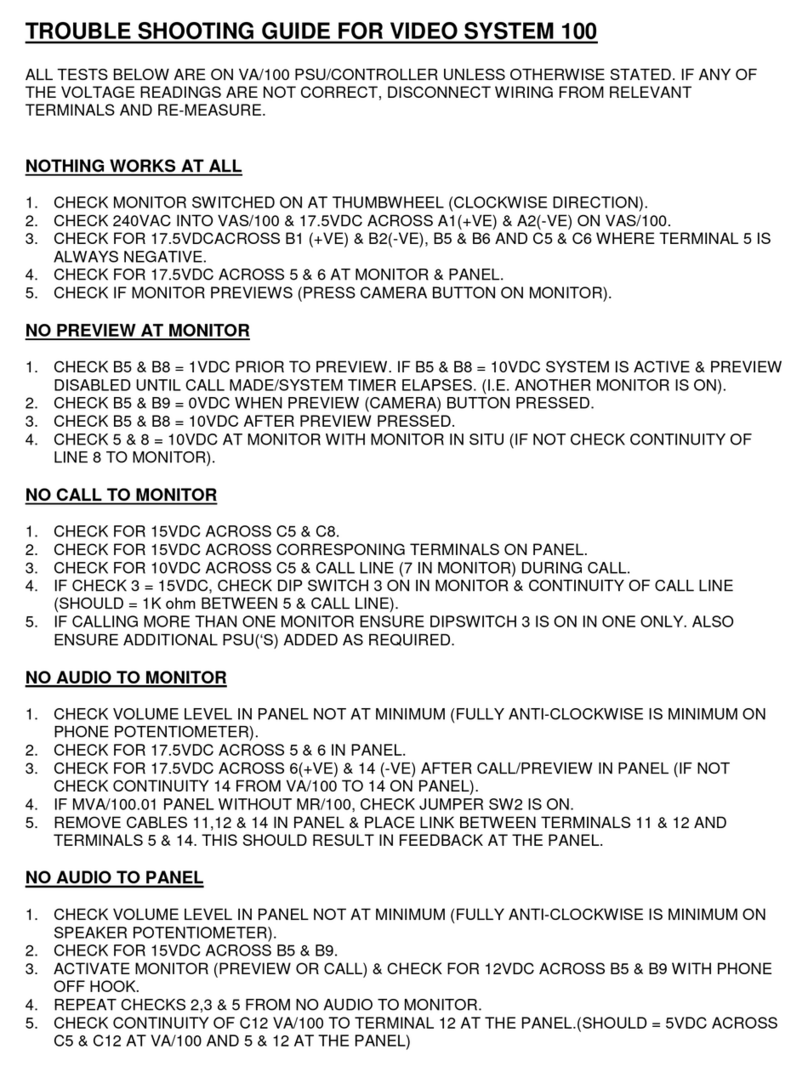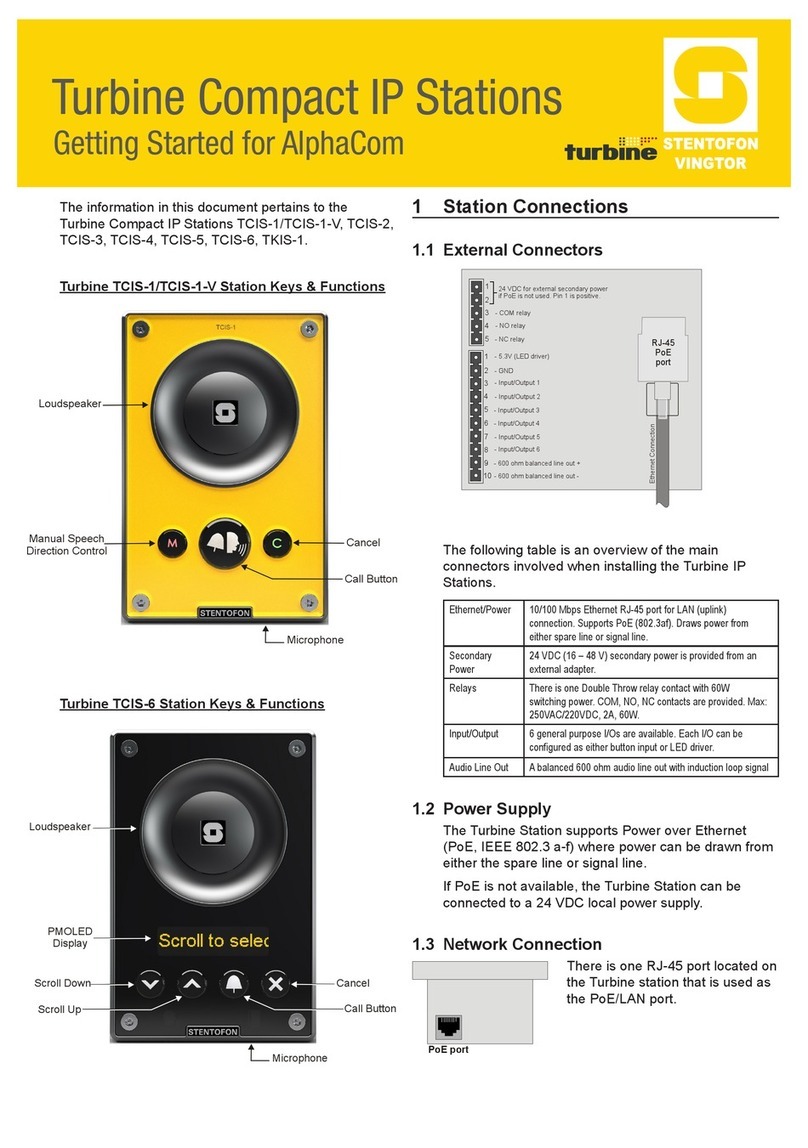Class Connection VC-24 User manual

Issue 1
www.class-connection.com
1 947226
VC-24
TALKBACK INTERCOM SYSTEM
EXPANDABLE 24/48/72/96 ZONE
CONTENTS
INTRODUCTION 1, 2
SPECIFICATIONS 2, 3
INSTALLATION 3, 4
Precautionary Information 3, 4
VC-24 Control/Connector Locations 5
Punchdown Block Connections 6
Attendant Port Connection 7
Background Music Connection 7
Door Speaker/Call Switch Connection 7
Inhibit Option 8
External Tone Source (ex.V-9927A) 8
SMDR Printer Port Cable 8
Override Page Port 9
Global All Call Page 9
Global Priority Page 9
Zone Page Option 10
Clock Sync 10
Dipswitch Options 11
Programming Tool 11-26
OPERATION 27,28 VC-24 with VC-24EXP Expansion Unit
Remote Station Access (Call Button) 28
Attendant Station Dialing Plan 28
TROUBLESHOOTING CHART 29
LIMITED WARRANTY 29
GLOSSARY OF TERMS 30
The VC-24 Talkback Intercom System provides 24 stations with one-way, two-way, group call and all call pages.
Each station can be programmed for one-way or two-way communication. The stations may be grouped into one-
way page groups. The system also provides the ability for a remote speaker location equipped with a call button to
call the attendant location. The attendant receives calling speaker identification when using a Caller ID equipped
telephone or a Caller ID display.
The VC-24 is compatible with standard 45 ohm speakers and one-way amplified speakers and can be accessed via a
single line phone, E-Key line port or PABX loop start trunk port. An RS-232 port on the control unit provides a
connection for a serial printer for printout of system activity.
The VC-24 provides a background music input and is designed to automatically mute music during a page. The
basic system also provides four (4) contact closures associated with the last 4 zones to allow for door strike plate
activation. Multiple VC-24 control units can be interconnected to allow global all call and global priority pages for
up to six (6) VC-24 control units.

2947226
The VC-24 Control Unit provides access to 24 stations. A VC-24EXP Expansion Unit is available for the VC-24.
Each VC-24EXP Expansion Unit will increase the capacity of the VC-24 by twenty-four (24) additional stations. Up
to three (3) Expansion Units can be added to a system for a total of 48, 72, or 96 zones of paging.
“WARNING: To reduce the risk of fire or electric shock, do not expose this appliance to rain or
moisture.”
“WARNING: Shock hazard – Do Not Open.”
“AVIS: Risque de choc Electrique ne pas Ouvrir.”
“PELIGRO: Corriente Electrica – No Abres.”
FEATURES
•24 zones of handsfree or one-way
communication (expandable up to 96 zones)
•Built-in handsfree amplifier
•Background music input
•Built-in all call with “meet me” and “follow me”
capability
•“Ring in” from speaker locations
•Calls placed in queue
•Dial tone programmable (On/Off)
•Alert tone
•Ringback tone
•Repeated alert/privacy tone programmable
(On/Off)
•Auxiliary contact closures for zones 21, 22, 23,
24
•Programmable ring pattern
•Ring contact closure follows ring cycle
•Inhibit input
•Caller identification
•RS-232 serial printer port
•Control unit is internally powered (battery
backup compatible; (1) VPB-260 per unit)
•Override port
•Emergency tone input
•Time tone input
•UNA contact closure input
•All call/priority page through up to six VC-24
systems of any size
•Group call
•Programmable class of service
•Time sync output
•Custom page groups
•Enhanced Caller ID
•Flexible Architectural numbering plan
•Interface to the PC Programming Tool
•Store user data to EEROM
•Real time clock for SMDR printer
•Auto detect for Com Port or Modem
•Auto adjust for Daylight Savings Time
•Evacuation tone to specified groups
•Time tones to specified groups
•Read software/firmware revision numbers
CAPACITY
•The VC-24 is a single talkpath unit.
•The maximum number of speakers per zone:
one 45 ohm speaker and/or forty (40) one-way
amplified speakers.
NOMINAL SPECIFICATIONS
These units are not intended for direct or indirect
connection to the public telephone network. When
used with a customer premise telephone system such
as a key system or PABX system, these units are
interfaced to the system via a fully protective paging
port or a system central port, which are fully
protected interface devices. Additionally, the host
system must be configured to disallow a central
exchange trunk conferencing in order to prevent
indirect connection to the network.
Attendant Port
•Loop Start Access (E-Key C. O. Line Position,
Single Line Phone, Trunk Port of PABX)
•DTMF Access
•Caller ID Compatible
•Tip and Ring Input Impedance: 600 Ω
•Tip and Ring Input Level: -10 dBm nominal
Ring Supply
90 Vac, 30 Hz - Ring Patterns:
2 sec ON, 4 sec OFF American
1 sec ON, 4 sec OFF Dutch
Double Ring British
Override Page Port
•Loop Start Access (E-Key C. O. Line Position,
Single Line Phone, Trunk Port of PABX)
•Telephone System Page Port Access

3947226
•Tip and Ring Input Impedance: 600 Ω
•Tip and Ring Input Level: -10 dBM nominal
Background Music Amplifiers
Input Impedance: 10 K Ω
Frequency Response: 50 Hz to 17 kHz +/- 3 dB
Distortion: < 1.0 %
Signal to Noise: -70 dB
Output Impedance: 45 Ω
Output Power: 1 watt per zone
Page Amplifiers
Frequency Response: 150 Hz to 7.5 kHz +/- 3 dB
Distortion: < 1.0 %
Signal to Noise: -70 dB
Output Impedance: 45 Ω
Output Power: 1 watt per zone
POWER REQUIREMENTS
Operating Voltage: 115, 230 Vac
Current: 1.0 Amp @ 115 Vac
0.5 Amp @ 230 Vac
Frequency: 50, 60 Hz
ADDITIONAL INPUTS
Inhibit (Ground Activated)
Emergency Tone Input
Input impedance: 10 K Ω
Input Level: -10 dBm
Time Tone Input
Input impedance: 10 K Ω
Input Level: -10 dBm
PRINTER PORT
Type: Serial
Baud Rate: 9600
8 Data Bits, No Parity, 1 Stop Bit
ENVIRONMENT
Temperature: 0 to 40 °C
Humidity: 0-85% Non-precipitating
DIMENSIONS/WEIGHT
•17.50”H x 10.31”W x 3.06”D
(44.45cm H x 26.19cm W x 7.77cm D)
•15 lbs. (6.8 kg)
MAIN UNIT CONTROLS
•Tone level for internally generated tones (one
control handles time, emergency and UNA tones)
•Tone level for externally generated tones (one
control handles time and emergency tones)
•Phone to speaker level
•Speaker to phone level
•Background music system-wide level control
•All call level
•Priority page level
AUXILIARY CONTACTS
•Contact Closures are available on Zones 21, 22,
23, and 24 (strike plates) (Main Unit). Each
contact operates when the respective zone
number is dialed and the “*” key is pressed
twice.
•Remote Signaling Closure (follows ring pattern)
250 mA max @ 24 Vdc.
PAGE PRIORITY
It is possible for multiple inputs to request an audio
connection to a speaker at the same time. When a
conflict occurs, the highest priority audio will be
connected. A lower priority input that is overridden
will be re-connected if it is still active in the system
when all higher priority inputs have ended. Priorities
from highest to lowest:
Override Phone
Emergency Tone (continued…)
Time Tone
Inhibit
Handsfree Call
External All Call Page
All Call Page
Group Call Page
Night Ring
Background Music
INSTALLATION
Precautionary Information
FCC Notice
This equipment has been tested and found to comply
with the limits for Class A digital devices, pursuant to
Part 15 of FCC Rules. These limits are designed to
CAUTION: To reduce the risk of electric shock,
Do not remove cover.
No user serviceable parts inside.
Refer servicing to qualified service personnel.
CAUTION
RISK OF ELECTRIC SHOCK
DO NOT OPEN
This symbol indicates that dangerous
voltage constituting a risk of electric
shock is present within this unit.
This symbol indicates that there are
important operating and maintenance
instructions in the literature accompanying
this unit.

4947226
provide reasonable protection against harmful
interference when the equipment is operated in a
commercial environment. This equipment generates,
uses, and can radiate radio frequency
energy and, if not installed and used in accordance
with the instruction manual, may cause harmful
interference to radio communications. Operation of
this equipment in a residential area is likely to cause
harmful interference in which case the user will be
required to correct the interference at his own
expense.
Mounting
The VC-24 was designed for wall mounting only.
Using the enclosed paper template, mark the locations
for the mounting screws on a plywood backboard
(minimum ½” thick). Insert screws and tighten to
within 1/8” of the surface. Hang the unit on the
screws, slide the unit left to the narrow end of the
slots and tighten screws firmly.
Connections
Mount (3) 66B type punchdown blocks on the
backboard near the VC-24 control unit. Make
connections to the punchdown blocks as specified in
Figure 2 - Punchdown Block Connections. (System
Inputs - Block P7, Speaker Outputs - Block P3,
Switch Inputs - Block P6). Also refer to the
following diagrams for connections of each
application.
Setting Option Switches
After all connections have been made, set the option
switches to fit the specific user requirements. Refer
to Figure 1 for location and Table 1 for the default
values of the various switches. Make changes as
required.
NOTE: This unit provides an option for
disabling Talkback Alert Tone and Repeating
Privacy Tones. Check local privacy
regulations prior to disabling these tones.
Power Connections
Use a cord set consisting of a minimum 18 AWG
cord and grounding type attachment plug rated a
minimum of 15A, 250V. The cord set should have
the appropriate safety approvals for the country in
which the equipment will be installed and marked
HAR.
The VC-24 may be provided with one of the
following:
•NEMA 5-15 cordset for North American use
•CEE/7 cordset for Continental European use
•BS1363 cordset for United Kingdom use
Connect cordset to unit via IEC 320 female connector located on one
end of cordset to IEC 320 male appliance coupler located on VC-24.
•For 115 VAC use, verify fuse rating of 1 amp and voltage
selector switch displays 115 V.
•For 230 VAC use, verify fuse rating of .5 amp and voltage
selector switch display 230 V.
•After all required connections have been made, plug the cordset
into appropriate AC wall outlet.
For United Kingdom use:
As the colors of the cores in the main lead may not
correspond with the colored markings identifying the
terminals in your plug, proceed as follows:
•The core which is colored green and yellow must
be connected to the terminal in the plug which is
marked with the letter E or by the earth symbol
(inverted Christmas tree), or colored green and
yellow.
•The core which is colored blue must be
connected to the terminal which is marked with
the letter N or colored black.
•The core which is colored brown must be
connected to the terminal which is marked with
the letter L or colored red.

5947226
Side View Top View
R79
R80
R82
R115
R81
P3 P7
P8
R16
R11 SW2
SW3
SW1
P10
P6
P10
AC
Power Fuse115/230
Switch Battery Backup
Connector
Switches:
SW1
SW2, SW3
SW4
- NOT USED
- NOT USED
- Battery Feed Switch (Priority Port)
Volume Controls:
R11
R16
R79
R80
R81
R82
R115
- Handsfree Speaker to Phone Level
- Handsfree Phone to Speaker Level
- Background Music Level
- External Tone Source Level
- All Call Adjust Volume/Attendant Level
- Override Port Page Level
- Internal Tone Source Level
P3
P6
P7
P8
P10
- 45 ohm Speakers (See Figure 2)
- Call-In Switch Inputs (See Figure 2)
- System Connections (See Figure 2)
- Expansion Unit Connector
- RS232 Serial Port for SMDR (DB9 Connector)
FIGURE 1 - VC-24 CONTROL AND CONNECTOR LOCATIONS
SW4
Connectors:
VC-24

6947226
FIGURE 2 - PUNCHDOWN BLOCK CONNECTIONS
Block P3 - Speaker Outputs Block P6 - Switch Inputs Block P7 - System Inputs
26
1
27
2
28
3
29
4
30
5
31
6
W/BL
BL/W
W/O
O/W
W/GR
GR/W
W/BR
BR/W
W/S
S/W
R/BL
BL/R
T STA 1
R STA 1
T STA 2
R STA 2
T STA 3
R STA 3
T STA 4
R STA 4
T STA 5
R STA 5
T STA 6
R STA 6
26
1
27
2
28
3
29
4
30
5
31
6
W/BL
BL/W
W/O
O/W
W/GR
GR/W
W/BR
BR/W
W/S
S/W
R/BL
BL/R
INA1
INB1
INA2
INB2
INA3
INB3
INA4
INB4
INA5
INB5
INA6
INB6
26
1
27
2
28
3
29
4
30
5
31
6
W/BL
BL/W
W/O
O/W
W/GR
GR/W
W/BR
BR/W
W/S
S/W
R/BL
BL/R
Tip - Attendant Tel
Ring - Attendant Tel
Common Audible C.C.
Common Audible C.C.
BGM Input
BGM Input
Riot Mode
Riot Mode
External Tone - Tip
External Tone - Ring
Clock Activate
Clock Activate
Group 1
32
7
33
8
34
9
35
10
36
11
37
12
R/O
O/R
R/G
G/R
R/BR
BR/R
R/S
S/R
BK/BL
BL/BK
BK/O
O/BK
T STA 7
R STA 7
T STA 8
R STA 8
T STA 9
R STA 9
T STA 10
R STA 10
T STA 11
R STA 11
T STA 12
R STA 12
32
7
33
8
34
9
35
10
36
11
37
12
R/O
O/R
R/G
G/R
R/BR
BR/R
R/S
S/R
BK/BL
BL/BK
BK/O
O/BK
INA7
INB7
INA8
INB8
INA9
INB9
INA10
INB10
INA11
INB11
INA12
INB12
32
7
33
8
34
9
35
10
36
11
37
12
R/O
O/R
R/G
G/R
R/BR
BR/R
R/S
S/R
BK/BL
BL/BK
BK/O
O/BK
Clock Enable C. C.
Clock Enable C. C.
Emergency Activate
Emergency Activate
Emergency Enable C. C.
Emergency Enable C. C.
Override Page Port - Tip
Override Page Port - Ring
Dry Priority Activate
Dry Priority Activate
Inhibit
Inhibit
Group 2
38
13
39
14
40
15
41
16
42
17
43
18
BK/G
G/BK
BK/BR
BR/BK
BK/S
S/BK
Y/BL
BL/Y
Y/O
O/Y
Y/G
G/Y
T STA 13
R STA 13
T STA 14
R STA 14
T STA 15
R STA 15
T STA 16
R STA 16
T STA 17
R STA 17
T STA 18
R STA 18
38
13
39
14
40
15
41
16
42
17
43
18
BK/G
G/BK
BK/BR
BR/BK
BK/S
S/BK
Y/BL
BL/Y
Y/O
O/Y
Y/G
G/Y
INA13
INB13
INA14
INB14
INA15
INB15
INA16
INB16
INA17
INB17
INA18
INB18
38
13
39
14
40
15
41
16
42
17
43
18
BK/G
G/BK
BK/BR
BR/BK
BK/S
S/BK
Y/BL
BL/Y
Y/O
O/Y
Y/G
G/Y
Schedule Contact Closure 1
Schedule Contact Closure 1
Schedule Contact Closure 2
Schedule Contact Closure 2
Schedule Contact Closure 3
Schedule Contact Closure 3
Schedule Contact Closure 4
Schedule Contact Closure 4
Global Priority Activate
Global Priority Activate
Global All Call Activate
Global All Call Activate
Group 3
44
19
45
20
46
21
47
22
48
23
49
24
Y/BR
BR/Y
Y/S
S/Y
V/BL
BL/V
V/O
O/V
V/G
G/V
V/BR
BR/V
T STA 19
R STA 19
T STA 20
R STA 20
T STA 21
R STA 21
T STA 22
R STA 22
T STA 23
R STA 23
T STA 24
R STA 24
44
19
45
20
46
21
47
22
48
23
49
24
Y/BR
BR/Y
Y/S
S/Y
V/BL
BL/V
V/O
O/V
V/G
G/V
V/BR
BR/V
INA19
INB19
INA20
INB20
INA21
INB21
INA22
INB22
INA23
INB23
INA24
INB24
44
19
45
20
46
21
47
22
48
23
49
24
Y/BR
BR/Y
Y/S
S/Y
V/BL
BL/V
V/O
O/V
V/G
G/V
V/BR
BR/V
Global Page Tip
Global Page Ring
Clock Sync
Clock Sync
Night Ring Activate
Night Ring Activate
Sta. 21 C. C.
Sta. 21 C. C.
Sta. 22 C. C.
Sta. 22 C. C.
Sta. 23 C. C.
Sta. 23 C. C.
Group 4
50
25 V/S
S/V N. C.
N. C. 50
25 V/S
S/V N. C.
N. C. 50
25 V/S
S/V Sta. 24 C. C.
Sta. 24 C. C.

7947226
Block P7 System Inputs
Sta.21 CC
Sta.22 CC
Sta.23 CC
Sta.24 CC
Block P3 Speaker Outputs
Block P6 Switch Inputs
Door Plate
Speaker
Pushbutton
Customer provided
door opening solenoid
-24 Vdc
Gnd
DOOR SPEAKER AND CALL SWITCH CONNECTION
ATTENDANT PORT CONNECTION
26
1
27
2
Tel. System
C. O. Line Port
T R
Telephone
T R
OR
Caller
ID Box
W/BL
BL/W
W/O
O/W
28
3
W/GR
GR/W
BACKGROUND MUSIC CONNECTION
P7 Connecting Block
P7 Connecting Block
Low Level
Music
Source
47
22
48
23
49
24
50
25
46
21
47
22
48
23
49
24
INA 21
INB 21
INA 22
INB 22
INA 23
INB 23
INA 24
INB 24
(STATIONS 21-24)
TSTA 21
RSTA 21
TSTA 22
RSTA 22
TSTA 23
TSTA 24
RSTA 24
RSTA 23
External
Signalling
Device
(STATIONS 1-20)
Door Plate
Speaker
Pushbutton
Block P3 Speaker Outputs
Block P6 Switch Inputs
INA 1
INB 1
INA 20
INB 20
26
1
45
20
26
1
45
20
TSTA 1
RSTA 1
TSTA 20
RSTA 20
Power Supply
for door solenoid
46
21
47
22
48
23
49
24

8947226
26
1
37
12
W/BL T
BL/W R
BK/O
O/BK Inh.
Inh.
Tel.Sys. C.O. Line
position or single
line telephone
Dedicated "Meet
Me" Telephone
T R A A1
5.1K Ohm
INHIBIT OPTION
P7 Connecting Block
P7 Connecting Block
30
5
32
7
34
9
Signal
Out
V-9927A
(1-8)
Com
EXTERNAL TONE SOURCE USING A V-9927A
*NOTE: External tone source requires programming option to enable
feature. See Table 1(SW3-8)
W/S
S/W
R/O
O/R
R/BR
BR/R
31
6
33
8
Control
from time
clock
Emergency
Closure
Normally
Open Switch
22
33
57
DB9 Female
DB25 Male
To P10
VC-24
Control
Unit
Baud Rate 9600, 8 bit, no parity, 1 stop bit
SMDR PRINTER PORT CABLE

9947226
P7 Connecting Block
42
17 44
19
P7 Connecting Block
44
19
P7 Connecting Block
44
19
GLOBAL PRIORITY PAGE (FROM OVERRIDE PAGE PORT)
42
17 42
17
VC-24 #1 VC-24 #2 VC-24 #3
NOTE: Global all call page requires programming option to enable feature.
Y/O
O/Y Y/BR
BR/Y Y/O
O/Y Y/BR
BR/Y Y/O
O/Y Y/BR
BR/Y
P7 Connecting Block
43
18 44
19
P7 Connecting Block
43
18 44
19
P7 Connecting Block
43
18 44
19
NOTE: Global all call page requires programming option to enable feature.
GLOBAL ALL CALL PAGE (FROM ATTENDANT DIAL UP)
VC-24 #1 VC-24 #2 VC-24 #3
Y/G
G/Y Y/BR
BR/Y Y/G
G/Y Y/BR
BR/Y Y/G
G/Y Y/BR
BR/Y
P7 Connecting Block Tel System
Page Port
(SW4 OFF)
Telephone
(SW4 ON) OR
35
10
36
11
OVERRIDE PAGE PORT
SW4 on the control board
must be set accordingly
R/S
S/R
BK/BL
BL/BK
TR

10 947226
P3 Speaker Outputs
ZONE PAGE OPTION
P6 Switch Inputs
26
1
27
2
28
3
70 Volt
Amp
V-1092
26
1
27
2
28
3
* To Enable Feature, strap must remain
across pair when unit is powered
CLOCK SYNC INPUT
45
20 Master
Clock
Y/S
S/Y
P7 Connecting Block
Master Clock must make contact closure at 0200 Hours.
TSTA1
RSTA1
TSTA2
RSTA2
TSTA3
RSTA3
INA1
INB1
INA2
INB2
INA3
INB3
ONE WAY ONLY

11 947226
Dipswitch Options - Basic System
Note SW1, SW2 and SW3 are not used in the VC-24 System.
Override Port Options
Switch OFF Switch ON
Main Board SW4 Tel. System Page Port Access Loop Start Trunk Port
INSTALLATION OF THE PROGRAMMING TOOL
The VC-24 Programming Tool is a windows based software tool designed to interface with the VC-24.
Minimum Computer Requirements for the Class ConnectionTM VC-24 Programming Tool:
Hardware:
•80486 (higher is recommended)
•Hard drive with 30 Mbytes free
•Mouse
•8 Mbytes of RAM (more is recommended)
•1 available serial communication port
Operating System:
•The Programming Tool is 32-bit and requires Windows 95, Windows 98, or Windows NT 4.0.
The programming tool software is furnished on 1.4 MB disks and must be installed to the hard drive. To install the
software:
•On the taskbar, click the Start button
•Insert disk 1
•Select Run
•Type a:\Setup (Assuming a: is the disk drive being used)
•Follow on-screen instructions for full installation, changing disks as the prompt requests
•The Class ConnectionTM VC-24 Programming Tool will automatically appear in the Programs list
USING THE PROGRAMMING TOOL
•On the taskbar, click the Start button, point to Programs, and select Class ConnectionTM VC-24
Programming Tool.
•The VC-24 Programming Tool splash screen appears momentarily and then the Programming screen
comes into view

12 947226
VC-24
System Configuration
To begin the programming process, click on File. A pull-down menu appears allowing selection of a previously
programmed file (click on Open) or the ability to create a new file (click on New). The following instructions
assume a New configuration file is being created. Click on New from the pull-down menu. A System Configuration
screen is displayed to allow selection of the installed components within the system.
Select one of the following from the list:
•For a 24-station system select Main Board.
•For a 48 station system select Main Board + Expansion 1.
•For a 72 station system select Main Board + Expansion 1, 2.
•For a 96 station system select Main Board + Expansion 1, 2, 3.
Press OK to accept the present selection or Cancel to re-select. When selection is complete, the
Programming Window Screen will be displayed. (To display the configuration of the system
press the Details button).

13 947226
VC-24
When OK is selected from the System Configuration screen, the Programming Window appears
- see below. The Programming Window allows each option to be accessed by selecting the
option and pressing Open or by double clicking on the selected option. All functions can be
listed at once by pressing Open All. (All of the options accessed through the Programming
Window can also be accessed from the pulldown menus).

14 947226
VC-24
Architectural Number and CLID (Caller ID) Programming
The first function to configure is the Architectural Number and CLID Programming.
The Architectural Number is a 1 to 4 digit number that is dialed by the phone to connect to a
specific speaker. Flexible architectural numbering is often selected to allow speakers and room
numbers to match. The CLID Programming allows a name or up to 15 characters description to
be entered for each station.
The information entered in the CLID description field will be displayed on the phone or Caller
ID unit if provided as part of the system.
The Edit Station Entry allows a CLID description to be entered for each station. Example:
105 would be the Arch # and MR. HALL would be the CLID description (15 character limit).
The Delete Station Entry allows removal of selected architectural and CLID descriptions.
Auto Numbering assigns the Arch # in sequential order. The beginning number is the currently
selected station; an ending number must be specified.
To Auto Number – Highlight station where architectural numbering begins.
Select Edit Station Entry. Enter beginning architectural number and select OK.
Select Auto Numbering and enter last architectural number (must be a higher number).
Select OK.

15 947226
Enter information for the Main Board as well as each Expansion Unit being used and press OK
to accept.
Audio Connections
This screen allows selection of groups to receive Background Music, Time Tones and
Emergency Tones. This sample system consists of a “Main Board + Expansion 1” so eight
groups are available to receive audio connections. (Each group contains six stations).
Group 1 Stations 1, 2, 3, 4, 5, 6 Main Board
Group 2 Stations 7, 8, 9, 10, 11, 12 Main Board
Group 3 Stations 13, 14, 15, 16, 17, 18 Main Board
Group 4 Stations 19, 20, 21, 22, 23, 24 Main Board
Group 5 Stations 25, 26, 27, 28, 29, 30 Expansion 1
Group 6 Stations 31, 32, 33, 34, 35, 36 Expansion 1
Group 7 Stations 37, 38, 39, 40, 41, 42 Expansion 1
Group 8 Stations 43, 44, 45, 46, 47, 48 Expansion 1
Click on the tab of the desired feature to program zones. Click on each group button to receive
the audio connection. If all groups are to receive an audio connection for the specific feature,
select Include All.

16 947226
The zones for each feature:
BGM, Time Tone and Emergency, are selected in the same manner.
Defaults: BGM - All Off
Time Tone - All On
Emergency - All On
After zones for each feature have been selected, press the OK button.
The Audio Connections screen disappears, with the Programming Window still being active to
allow selection of other options.
Class of Service.
Class of Service defines how a call originated by a button press will be queued for answer by the
attendant.
•Emergency Only - Top priority. Stations programmed as Emergency Only are moved to the
top of the priority list to be answered first.
•Normal/Emergency - Calls from stations programmed as Normal/Emergency are received in
the queue as they are made. 1 button press from the station, the call is received as a normal
call; 4 button presses from the station, the call is received as an emergency call.
•Normal Only - Calls from stations programmed as Normal Only are received in the queue as
Normal priority whether 1 or 4 button presses are made at the calling station.
Set the Class of Service for all Groups on the Main Board as well as any Expansion Boards.
Press the down arrow at the end of the Class of Service field to display the available types of
service for selection.
When finished, press the Close button.

17 947226
Default option of all stations, with or without the Option Board installed, is
Normal/Emergency.
Custom Page Groups
When Custom Page Groups is selected, the following screen is displayed.
There are 4 Custom Page Groups available.
Select the Page Groups to receive custom paging by clicking on the desired box. Each Custom
Page Group can contain all groups or a combination of groups. (Example: Custom Page Group
50 could contain page groups 1, 2, and 3 and Custom Page Group 52 could contain page groups
1, 2, 7, and 8).
Select OK after all desired page groups are defined.

18 947226
Master Clock Schedule
The Master Clock Schedule has 6 separate schedules with up to 256 total events. The user
defines how these events are to be distributed between schedules.
Dial codes may be used to force a schedule or to turn a schedule off. #94X forces schedule on
with the X being the number of the schedule (i.e. #941 will force Schedule 1). #940 turns off the
active schedule.
•Select Schedule 1-6.
•Click Open.
•Displays Schedule 1 menu.
•Choose which days schedule is to be active.
•Select Add.
New Event Screen menu will be shown. Select Start Time. Select which Relay Type you want
to follow the Schedule, and Select the Relay Duration of the contact closure. Select which Page
Group(s) tone should go to. Select Save.
NOTE: The contact closure pairs 13, 14, 15, 16 on the system punchdown block, should be
wired to the tone select input of an external tone generator (V-9927A). The tone output of the
external tone generator should then be wired to the external tone input of the VC-24, pair 5 of the
system punchdown block.

19 947226
System
Next select System from the Programming Window. A check in the box means ON (selected);
an empty box means OFF (not selected). Select the desired options and click on OK to exit this
screen. The options are described in more detail in the Control Unit (VC-24) document or select
Help from the pull-down menu for on-screen details.
The Dip Switch button displays the dip switch equivalent (see next page) of the options selected
with the programming tool. Note that SW2 and SW3 are not used with the VC-24 System.

20 947226
Dip switch equivalent of programmed options.
Table of contents

